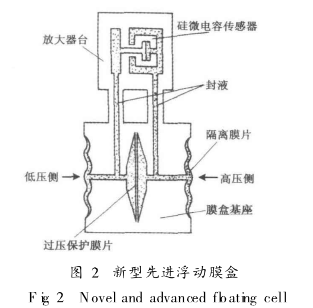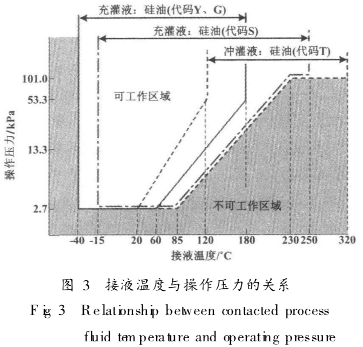FCX-III series smart transmitters use silicon microcapacitance sensors and microprocessors manufactured by micromachining technology, new advanced floating diaphragm structure, multiple communication protocols and other original key technologies, so that the series products have excellent characteristics and Function.
1.1 Silicon Microcapacitive Sensor
Figure 1. The structure diagram of the silicon microcapacitive sensor. Its measurement principle is the same as that of the traditional capacitive sensor, but the materials, structure and manufacturing process used have many unique features, so it has the following excellent characteristics:
1 Miniaturized, the size of the sensor is very small, only 7 x 7x 9mm after packaging.
2 Silicon diaphragms. The measuring diaphragm is made of single crystal silicon material. Silicon material has many excellent properties, and the thermal expansion coefficient is only 1/4 of that of metal diaphragm, so it is less affected by environmental temperature changes, and the fatigue performance of the material is smaller than that of metal diaphragm. , good long-term stability, silicon material has no elastic hysteresis, can achieve ideal linear characteristics, the hysteresis of the instrument can be ignored, can be used for a long time without the need to adjust the zero point.
3 micro displacements. For sensors of various specifications and ranges, under the maximum measurement range, the maximum displacement of the silicon diaphragm is only 4Um, which is dozens of times smaller than the working displacement of the micro-displacement transmitter. Under such a small displacement, The proportional relationship between pressure and displacement is accurate. In addition, the measuring diaphragm adopts a groove-like structure, and the movement of the diaphragm is close to the ideal parallel plate capacitor, because the instrument has good linearity and high precision.
4. Capacitive measurement principle. Capacitive transmitters have more than 30 years of application experience in various industrial occasions. Fuji has nearly 1 million units in the world. Wide applicable temperature range.
5 The sensor adopts MEMS (Micro Electro Mechanical) manufacturing technology. The sensor is photoetched on a single crystal silicon wafer, so it is small in size, low in power consumption, fast in response, easy to integrate and ensure the consistency of the sensor.

1.2 New advanced floating diaphragm
The new advanced floating bellows structure is shown in Figure 2, which can protect the sensor in various harsh environments, ensure the stability of the sensor operation, and is easy to operate and set up on site. Temperature characteristics, static pressure characteristics, and overvoltage protection characteristics are better than traditional products.
Its characteristics are as follows:
1 Excellent temperature characteristics
The small silicon microcapacitance sensor is moved from the lower part of the capsule to the inside of the amplifier stage, which keeps the sensor away from the process medium. Therefore, the sensor is less affected by the temperature change of the process medium. At the same time, a temperature sensing element is installed inside the sensor, according to the temperature sensor detection. When the temperature changes, the microprocessor of the transmitter can correct the influence of the temperature change at any time, so the temperature characteristics of the instrument are very good.

2 The influence of static pressure is small
The sensor is mechanically isolated from the process medium and the external environment, which changes the force condition of the sensor. Under the action of high process pressure, the diaphragm base will be radially deformed by the axial force. However, the force of the sensor at this time is transmitted through the sealing liquid. Since the silicon microcapacitance sensor is surrounded by the sealing liquid, it is subjected to the effect of uniform pressure in different directions around it and will not deform, so the static pressure of the instrument has little influence.
3 Reliable one-way overvoltage protection
The overpressure protection diaphragm in the middle of the bellows is no longer a measuring diaphragm. When the instrument is working normally, the overpressure protection diaphragm will not be displaced due to the action of the measuring pressure, and it will bend only when there is one-way overpressure. The starting pressure of the overpressure protection diaphragm is 3 times the maximum measurement range. When the transmitter is subjected to one-way overpressure, the overpressure protection diaphragm is bent and deformed, and a part of the sealing liquid is absorbed at this time until the isolation diaphragm The diaphragm is close to the protective corrugation of the diaphragm base, and the external pressure has lost the medium for transmitting the pressure---the sealing liquid, so the continuous rise of the sealing liquid pressure is suppressed. At this time, the measuring diaphragm of the sensor (silicon diaphragm ) is only subjected to 3 times the maximum measuring range pressure, thus playing a one-way protection role. When the one-way pressure is removed, the measuring diaphragm and the overpressure protection diaphragm can quickly return to their original positions due to the elastic properties of the material. This reliable one-way overpressure protection feature enables the transmitter to be installed in the field by introducing process pressure directly into the transmitter's measurement chamber without the need for an additional three-valve manifold.
4 The structure is more compact and the volume is smaller
The small micro-silicon capacitive sensor is moved into the amplifier stage, so that the structure of the capsule is simple and compact, the volume is greatly reduced, and the field operation is more convenient.
2 Provide special purpose solutions
2.1 Hydrogen proof transmitter
"Hydrogen permeation resistant" products specially made for the hydrocracking, desulfurization, hydrogen production and other devices of petroleum and chemical enterprises. The patented technology is used to coat the surface of the isolation diaphragm with gold and ceramics, which realizes the protection of hydrogen permeation and effectively solves the problem. It solves the difficult problem of hydrogen-containing medium measurement, and the field application effect is very obvious. The unique double-coated isolation diaphragm can prevent hydrogen permeation. The dense gold-plated layer can delay the hydrogen permeation rate and prolong the service life of the instrument. The ceramic coating plays the role of electrical insulation and hydrogen isolation, preventing the hydrogen ions in the medium and the diaphragm. The combination of electrons fundamentally solves the problem of hydrogen permeation.
2.2 Application of high temperature and high vacuum
The decompression tower of the atmospheric and vacuum unit of the refinery is in a negative pressure state during normal operation. The source and composition of the raw materials are different, and the operating pressure is not the same. High temperature and high vacuum requirements.
In 2015, a domestic user used several Fuji FCX-AIII series double flange differential pressure transmitters. Less than three months after the instrument was put into operation, the output was unstable and the zero drift was too large. Subsequently, the working conditions and installation conditions of the site were investigated and analyzed, and the operating pressure was measured to be -96kPa, and the temperature of the remote flange isolation diaphragm in contact with the liquid was all below 200 °C. From this, it is determined that the key factor for the malfunction of the instrument is: the influence of high temperature and vacuum is considered in the initial selection, but the mutual influence of the liquid temperature and operating pressure is ignored. The original designed operating pressure is about -80kPa, but the actual operating pressure is -96kPa, as shown in Figure 3.

When the operating pressure is -96kPa (4kPa is absolute), the temperature of the wetted part should be below 100°C, and the actual working conditions on site exceed the normal working area of the instrument, so a drift phenomenon will occur, and corresponding solutions are proposed accordingly. , that is, a special transmitter for high temperature and high vacuum is used, and its temperature and pressure characteristics are shown in Figure 4. When the operating pressure is 4kPa absolute pressure and the liquid temperature is below 200℃, the long-term stability and reliability of the transmitter can be guaranteed. The replaced transmitter works stably.
The high-temperature and high-vacuum flange transmitter adopts the original processing method and assembly process, and can perform stable measurement even under the harsh process conditions of high temperature of 200 ° C and high vacuum of 0.27kPa absolute pressure, which meets the requirements of refinery decompression devices. It has provided solutions for many users.
2.3 Solutions for Corrosive Media Measurements

In May 2017, a double-flange transmitter of the above-mentioned pressure reducing device had a large output fluctuation phenomenon again. When the instrument was removed for inspection, it was found that the isolation diaphragm of the remote flange had many micro-holes. The reason for the investigation was that the low-priced crude oil imported at that time had high sulfur content, which caused strong corrosion to the instrument, and the micropores of the isolation diaphragm were caused by sulfur corrosion.
For the liquid level measurement under such high temperature, high vacuum and strong corrosion conditions, how to adapt the remote flange transmitter to this working condition is indeed a big problem. For corrosion doll high temperature, high vacuum double flange transmitter and ordinary differential pressure, pressure transmitter isolation diaphragm surface gold-plated, ceramic-plated technology based on patented products, specially developed a special flange transformer suitable for this working condition The transmitter was delivered to users for installation in November 2017. It has been put into use since March this year, and the use effect is good, effectively solving this problem.





